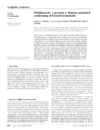issue contents
June 2006 issue

Cover illustration: Curvature mapping onto a surface drawn using the program Curvis. Courtesy of S. Piotto & R. Nesper [J. Appl. Cryst. (2005), 38, 223-227].
research papers
The Laplace transform approach is combined with the separated form factor (SFF) approximation to obtain expressions for form factors for polydisperse spherical vesicles with various forms of membrane scattering length density profile. The SFF approximation is tested against exact form factors that have been numerically integrated over the size distribution, and is shown to represent the vesicle form factor accurately for typical vesicle sizes and membrane thicknesses.
A new method for calculating the instrumental function in powder diffraction is described.
A method for studying conformation spaces in n dimensions has been developed. The method is used to calculate preferences of conformation families for the purpose of model building.
The diffraction profiles from bent Si-single-crystal strips measured in the symmetric Bragg geometry with slits or CCD-based optics contain secondary `mirage' peaks in addition to the primary 004 reflections. These dynamical diffraction artefacts cause errors in strains calculated from the angular positions of the 004 peaks; possible ways to eliminate/minimize such errors are discussed.
Open  access
access
 access
accessThe development of a microscope tilting-stage suitable for use with birefringence imaging is described, thus enabling precise three-dimensional birefringence information of uniaxial crystals to be obtained.
The original option SOLV of the program PLATON, which is primarily devoted to the study of organic structures, has been extended to studies of microporous inorganic crystals.
Open  access
access
 access
accessA simple analytical expression that allows one to model the instrumental resolution function of synchrotron radiation powder diffractometers in the presence of focusing optics is formulated. Experimental evidence of the validity of the model is also provided.
A direct method is presented for obtaining the mean orientation-dependent elastic strains/stresses in polycrystalline materials from diffraction strain pole figures. Due to the inherent indeterminacy of this procedure, referred to as strain pole-figure inversion, a trial solution is chosen by satisfying a well-posed auxillary problem where conditional control is imposed to address the issues of robustness and physical relevance.
Crystal-chemical parameters of P63/m apatite extracted directly by least-squares refinement are nearly one order of magnitude more precise than those obtained through analysis of standard Rietveld refinement results and are more consistent with single-crystal results. The comparable numerical stability of both types of refinement is assessed by singular value decomposition of the least-squares matrix of normal equations.
The microstructural characteristics of integrated pin-shaped two-dimensional and three-dimensional ferroelectric capacitors were analysed using an original approach combining micro-focused synchrotron X-ray fluorescence and diffraction. Various capacitor arrays were scanned with a step size of 0.2 µm while simultaneously acquiring fluorescence spectra and diffraction patterns in order to obtain, respectively, chemical and crystallographic mapping of the thin films constituting the capacitors.
Four bioapatites of human-, goat- and rabbit-bone and human-teeth origin, and one synthetic hydroxyapatite prepared via microwave irradiation have been analyzed by powder XRD and FTIR techniques. The Rietveld analyses indicate partial replacement of phosphate ions by carbonate ions in all bioapatites.
Open  access
access
 access
accessX-ray powder diffraction has been used to characterize 12 microcrystalline formulations of insulin. Differences and similarities between the polymorphs could be visualized by principal-component analysis.
The so-called X-ray elastic factors Fij(φ, ψ, hkl) are shown to have all the properties of a second-rank tensor. This leads to some conclusions that are helpful in the application of F.
Open  access
access
 access
accessA deconvolution method for diffraction measurements based on a statistical learning technique is presented. The method allows predictions of both the convolution and the underlying function from noisy measurements, and in addition provides an estimation of the prediction uncertainty, i.e. error-bars.
Topographs were collected for several reflections of a protein crystal at room and then cryo temperatures. At the cryogenic temperatures, a significantly increased mosaicity, with the overall original domain structure maintained but in a shattered state, is revealed along with increased background around the diffraction spots.
The scattering cross section of grazing-incidence small-angle scattering from thin supported mesoscopically structured polymer films is calculated in the framework of the distorted-wave Born approximation. The two cases of parallel and perpendicular lamellar orientation are considered.
short communications
Open  access
access
 access
accessSi (111) wafers deformed at elevated temperatures into cylindrical or hemispherical shapes have been examined by X-ray diffraction. The 333 peak shifts observed by ω scans showed that the (111) planes maintained their relationship with respect to the surface with a good crystal quality after the plastic deformation.
computer programs
Open  access
access
 access
accessA graphical user interface to define a range of crystallization conditions for optimization of protein crystallization on a routine basis is described.
New features in the Mercury crystal structure visualizer include the display of multiple structures, atomic displacement ellipsoids, simulated powder patterns and predicted morphologies, improved control over the graphical display, and options for presenting data in tables and spreadsheets.
Singular value decomposition tools developed here to assess the comparable numerical stability of crystallographic and crystal-chemical types of refinement described in the work by Mercier et al. [J. Appl. Cryst. (2006), 39, 369–375] have general applicability for troubleshooting problematic Rietveld refinements.
Software for digital topography data collection and analysis has been created.
notes and news
Free 



 journal menu
journal menu









































